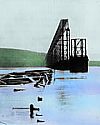
On 1 Jun 1878, the original Tay Bridge was officially opened by Queen Victoria. It carried a single rail line across the Forth of Tay on the east coast of Scotland. At almost 2 miles in overall length, it was for its time the world's longest bridge. The engineer was Thomas Bouch, who supervised construction, and was knighted for his work.
Sadly, the structure was inadequate in both design and quality to withstand gale force winds, and on 28 Dec 1879, its cast iron piers collapsed as a train crossed the high navigation spans. The engine and carriages fell into the water taking over 75 passengers to their deaths. An official inquiry found Bouch at fault, and that poor maintenance procedures weakened the piers and contributed to the failure.
An article on the construction of the Tay Bridge by Albert Groethe, Manager of the Tay Bridge Contract, published in the year it opened, 1878, explains why the bridge was needed, how adverse weather was encountered while it was being erected, and shows a Victorian optimism while the imminent tragedy-to-be remained unforeseen.
The article still makes very interesting reading for the engineering techniques employed in the building of a bridge that at the time was meeting a challenge never before attempted.

On 1 Jun 1979, Werner Forssmann died, the German surgeon who shared a Nobel Prize. His award was made for the development of cardiac catheterization - a tube inserted through a vein at the elbow and passed through the vein into the right atrium of the heart. After practice on cadavers, he introduced a 65-cm catheter to his own heart, walked up several flights of stairs to the x-ray department and calmly confirmed that the tip of the catheter had reached his heart.
Today's Science Store pick is:Today's book pick is: Mavericks, Miracles, and Medicine: The Pioneers Who Risked Their Lives to Bring Medicine into the Modern Age, by Julie M. Fenster, who writes engagingly about the persecuted pioneers behind some of medicine's greatest achievements. Some risked their lives, others their reputation, fortune, or career. These tales of medical discovery, detection, and invention includes also ambiguous successes of men like the “X-ray martyrs” whose self-experimentation led to slow, painful deaths. All make intriguing reading.
It is available from Amazon, typically about New from $14.99. Used from $3.68. (As of earlier time of writing - subject to change.)
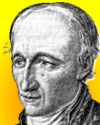 | A casual glance at crystals may lead to the idea that they were pure sports of nature, but this is simply an elegant way of declaring one’s ignorance. With a thoughtful examination of them, we discover laws of arrangement. With the help of these, calculation portrays and links up the observed results. How variable and at the same time how precise and regular are these laws! How simple they are ordinarily, without losing anything of their significance! The theory which has served to develop these laws is based entirely on a fact, whose existence has hitherto been vaguely discerned rather than demonstrated. This fact is that in all minerals which belong to the same species, these little solids, which are the crystal elements and which I call their integrant molecules, have an invariable form, in which the faces lie in the direction of the natural fracture surfaces corresponding to the mechanical division of the crystals. Their angles and dimensions are derived from calculations combined with observation. |
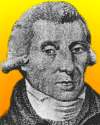 | Geological facts being of an historical nature, all attempts to deduce a complete knowledge of them merely from their still, subsisting consequences, to the exclusion of unexceptionable testimony, must be deemed as absurd as that of deducing the history of ancient Rome solely from the medals or other monuments of antiquity it still exhibits, or the scattered ruins of its empire, to the exclusion of a Livy, a Sallust, or a Tacitus. |
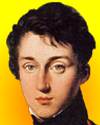 | The thermal agency by which mechanical effect may be obtained is the transference of heat from one body to another at a lower temperature. |
| Before you look at today's web page, see if you can answer some of these questions about the events that happened on this day. Some of the names are very familiar. Others will likely stump you. Tickle your curiosity with these questions, then check your answers on today's web page. | |
| Births | |
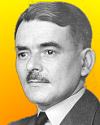 | Sir Frank Whittle, born 1 June 1907, was an English aviation engineer and pilot who developed aircraft that could fly at faster speeds and higher altitudes than piston-engine propeller airplanes of the 1920s. Beginning in 1930, while still only in his early 20's, he had designed and patented a new form of propulsion. What was his pioneering invention? |
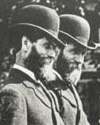 | On 1 Jun 1849, twin brothers were born - Francis and Freelan Stanley - who would become famous for their early design and manufacturing of automobiles. They began this work in 1897 and formed the Stanley Motor Carriage Company on 21 Feb 1902. They built vehicles until 1924. They produced thousands of them. In 1906, they set a world record for the fastest mile - 28.2 seconds (127 mph or 205 kph). What powered their automobiles? |
| Deaths | |
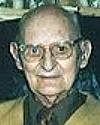 | Sir Christopher Cockerell (1910-1999) was an electronics engineer with the Marconi Company (1935-50) where he worked on airborne navigational equipment and on radar. But this had little to do with the pioneering invention for which he is known. Once he began his own boat-hire business, he turned his attention to a new form of watercraft. In 1954, he performed a crucial experiment to test his idea using kitchen scales, tin cans, and a vacuum cleaner. What watercraft did he invent? |
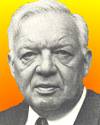 | Werner Forssmann (1904-1979) was a German surgeon who shared the Nobel Prize for Physiology or Medicine in 1956 for the development of a new surgical technique. He used a catheter in a new way. This was a tube inserted through a vein passed through the vein deep into the body. Drugs could then be introduced through this. After practice on cadavers, he introduced a 65-cm catheter into his own body, walked up several flights of stairs to the x-ray department and calmly confirmed the location of the catheter. What was the target in the body of his catheter procedure? |
| Events | |
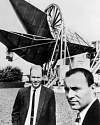 | In 1965, A. Penzias and R. Wilson detected a very low temperature primordial background radiation using a horn reflector antenna built for radio astronomy. The Big Bang origin of the universe 13.7 billion years ago was an explosion from a hot dense state. The high energy radiation produced when the universe was very young and very hot would have been absorbed and degraded as the universe expanded and cooled. The microwave background radiation is what remains of that dissipated radiation. What temperature did this background radiation represent? |
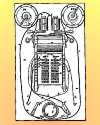 | In 1869, a prodigious American inventor received his first patent. It was for an “electrographic vote recorder.” The device was the first of its kind, and would enable a legislator to register a vote either for or against an issue by turning a switch to the right or left. Can you name this inventor? |
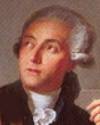 | In 1768, a famous French chemist sat for the first time at the Royal Academy of Sciences. He had been on the list of candidates for two years. The death of Théodore Baron had liberated a place at the Academy for a chemist and supported by his father’s friends, and others, he was elected. His first papers were reports on analysis: studies of gypsum, the diamond, meteorites, charcoal, lead and mineral waters Can you name this chemist? |
Fast answers for the previous newsletter for May 31: nitric oxide (NO) • a connection between solar variations and weather on Earth • asymmetrical shapes of certain atomic nuclei • first woman to gain the M.D. degree from a medical school in the United States • the decade including the year 1879 • dating from about the 3rd century, they were used then by the Christians of Rome since they were forbidden to bury their dead in regular burial grounds. • Dr. John Harvey Kellogg.
 If you enjoy this newsletter, the website, or wish to offer encouragement or ideas, please send feedback by using your mail reader Reply button.
If you enjoy this newsletter, the website, or wish to offer encouragement or ideas, please send feedback by using your mail reader Reply button. Your click on a Facebook, StumbleUpon, or other social button on the site webpages is also a welcome sign of appreciation. Thank you for using them.
© This newsletter is copyright 2020 by todayinsci.com. Please respect the Webmaster's wishes and do not put copies online of the Newsletter — or any Today in Science History webpage. (If you already have done so, please remove them. Thank you.) Offline use in education is encouraged such as a printout on a bulletin board, or projected for classroom viewing. Online, descriptive links to our pages are welcomed, as these will provide a reader with the most recent revisions, additions and/or corrections of a webpage. For any other copyright questions, please contact the Webmaster by using your mail reader Reply button.
--
If you do not want to receive any more newsletters, Unsubscribe
To update your preferences and to unsubscribe visit this link
Executive Real Estate Business Class
-
"It was like a man with wings. It wasn't like anything you'd see on TV or in a monster movie." ...
About the publisher
Search This Blog
Blog Archive
-
▼
2021
(585)
-
▼
June
(64)
- On This Day for June 30 - Night of the Long Knives...
- Newsletter for Wednesday 30 June.
- On This Day for June 29 - London's Globe Theatre d...
- Newsletter for Tuesday 29 June.
- On This Day for June 28 - Assassination of Archduk...
- Newsletter for Monday 28 June.
- On This Day for June 27 - Yen made official moneta...
- Newsletter for Sunday 27 June.
- On This Day for June 26 - Opening of CN Tower, Bab...
- Newsletter for Saturday 26 June.
- On This Day for June 25 - Korean War begun, Antoni...
- Newsletter for Friday 25 June.
- On This Day for June 24 - Russia invaded by Napole...
- Newsletter for Thursday 24 June.
- On This Day for June 23 - Battle of Bannockburn, C...
- Newsletter for Wednesday 23 June.
- On This Day for June 22 - Mutiny against Henry Hud...
- Newsletter for Tuesday 22 June.
- On This Day for June 21 - Japanese forces defeated...
- Newsletter for Monday 21 June.
- On This Day for June 20 - Casket Letters found, Ho...
- Newsletter for Sunday 20 June.
- Tonight at 8/7c: Watch ‘Fight the Power’
- On This Day for June 19 - Rosenbergs executed for ...
- Newsletter for Saturday 19 June.
- On This Day for June 18 - War of 1812 begun, Sir P...
- Newsletter for Friday 18 June.
- On This Day for June 17 - Arrest of O.J. Simpson, ...
- Newsletter for Thursday 17 June.
- On This Day for June 16 - First woman in space, Jo...
- Newsletter for Wednesday 16 June.
- On This Day for June 15 - Magna Carta sealed by Ki...
- Newsletter for Tuesday 15 June.
- On This Day for June 14 - First prisoners at Ausch...
- Newsletter for Monday 14 June.
- On This Day for June 13 - Historic meeting between...
- Newsletter for Sunday 13 June.
- On This Day for June 12 - Election of Boris Yeltsi...
- Newsletter for Saturday 12 June.
- Listen Now! Blindspot: Tulsa Burning Podcast
- On This Day for June 11 - Oklahoma City bomber exe...
- Newsletter for Friday 11 June.
- On This Day for June 10 - First “witch” hanged in ...
- Newsletter for Thursday 10 June.
- On This Day for June 9 - Landslide reelection vict...
- Newsletter for Wednesday 9 June.
- On This Day for June 8 - Michelangelo's David inst...
- Newsletter for Tuesday 8 June.
- Action required: Update your HistoryExtra password
- On This Day for June 7 - Lateran Treaty ratified, ...
- Newsletter for Monday 7 June.
- On This Day for June 6 - Normandy Invasion begun, ...
- Newsletter for Sunday 6 June.
- On This Day for June 5 - Start of the Six-Day War,...
- Newsletter for Saturday 5 June.
- On This Day for June 4 - Dunkirk evacuation ended,...
- Newsletter for Friday 4 June.
- Tonight: ‘Alone’ Returns at 9:30/8:30c
- On This Day for June 3 - Pro-democracy protest in ...
- Newsletter for Thursday 3 June.
- On This Day for June 2 - Elizabeth II crowned quee...
- Newsletter for Wednesday 2 June.
- On This Day for June 1 - Debut of CNN, Morgan Free...
- Newsletter for Tuesday 1 June.
-
▼
June
(64)
-
Blogroll
-
About
HistoryFact










0 comments:
Post a Comment